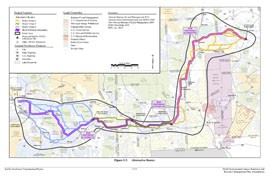Cronkite News has moved to a new home at cronkitenews.azpbs.org. Use this site to search archives from 2011 to May 2015. You can search the new site for current stories.
Feds open comment on 500-mile New Mexico-Arizona power line
WASHINGTON – Federal officials have unveiled draft plans for a proposed $1.5 billion power line linking central New Mexico with southeast Arizona across at least 460 miles of federal, state, local and privately owned lands.
The Bureau of Land Management said Tuesday that it is seeking public comment on the SunZia Southwest Transmission Line Project that calls for two new 500 kilovolt transmission lines and up to five new substations, depending on the final route selected.
The transmission lines are expected to spur development of renewable energy resources – including wind, solar and geothermal energy – throughout the desert Southwest by linking the region to an interstate power grid.
The SunZia project would also help modernize the electrical grid and increase reliability in the region by adding up to potentially 3,000 to 4,500 megawatts of electricity. That will help relieve an outdated, maxed-out power system, said Bill Merhege, the Bureau of Land Management‘s deputy state director for lands and resources in New Mexico.
“There’s no more space in the existing lines to move any more power than what they’re doing now,” he said. “They just can’t get enough power.”
But Rep. Raul Grijalva, D-Tucson, said it is imperative that the right alignment be chosen to protect rural communities and minimize environmental harm. The preferred alternative laid out by the bureau does not do that, he said.
“We can’t move forward without keeping the environment in mind,” Grijalva said in press release. “BLM’s current preferred alternative for Route Group 4 is more about future development interests than finding the least-intrusive route for this current project, as the law demands.”
Grijalva also said any final alignment must “protect the resources of the San Pedro River watershed,” which he said is a major corridor for migrating birds.
“We need, and the public demands, a final route that has the fewest negative impacts to archaeological resources, migratory birds and rural communities,” Grijalva’s statement said.
Sandy Bahr, director of the Grand Canyon Chapter of the Sierra Club, said that Arizona’s watershed regions especially must be protected.
“We just don’t really have very many flowing rivers in Arizona, so the ones we have are very important,” she said.
Supporters say the project could create 6,200 jobs over its four-year construction period, scheduled to begin in 2014, and up to 600 permanent jobs once the line becomes operational in 2016.
An economic impact study for the project predicted county-by-county job creation. Northern Oro Valley Chamber of Commerce President and CEO Dave Perry hailed the 30 permanent jobs the project is expected to bring to Pima County.
“In a place that has lost so many construction jobs, 30 jobs is always going to be welcome,” Perry said. “Is it a huge number of jobs in a county of a million people? No, but with so many jobs lost, you take whatever you can get.”
The project, proposed by SunZia Transmissions LLC, is one of seven fast-tracked by the Obama administration for its renewable-energy-development and power-generation capabilities.
The lines would originate at one of two points in New Mexico and run to the existing Pinal Central Substation near Coolidge, Ariz. Alternate routes are still being considered.
Public meetings will be held on the project but have not yet been scheduled. They will be announced at least 15 days prior to the scheduled dates.
Written comments must be received by the bureau on or before Aug. 22 to be considered.







